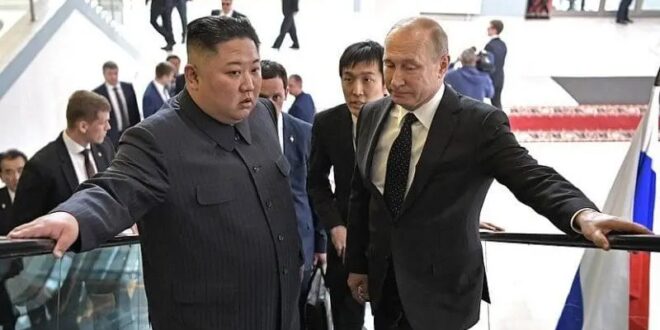On 13 October, Ukrainian President Volodymyr Zelensky said that North Korea was transferring people to the armed forces in Russia. A few days later, Ukrainian intelligence announced that the first North Korean military units had arrived in the war zone in Russia’s Kursk Oblast.
Intelligence estimates suggest North Korea has sent over three million artillery shells to support Russia’s invasion of Ukraine from 2022–24. Moscow has dispatched high-level officials to Pyongyang to tour weapons factories and assets. Anti-tank systems, rifles, rocket launchers and other assets are likely part of what are now regular container shipments from North Korea to Russia.
The countries have reforged bilateral ties on the back of these transactions, marked by a new security pact signed by North Korean Chairman Kim Jong-un and Russian President Vladimir Putin at a summit in June 2024. The treaty features a Cold War-era military intervention provision that raises the stakes for security in the Korean peninsula and beyond.
But this new pact does not present particularly novel threats for the United States and its allies. Many provisions in the newly signed ‘Treaty on the Comprehensive Strategic Partnership’ reflect activities between the two countries that have been going on for years. This highlights the inadequate and ineffective intervention by the international community, which permitted this dangerous friendship to flourish.
The part of the Treaty that has received the most attention is Article 4, which stipulates that both nations must ‘immediately provide military and other assistance by all means available’ if either faces an armed attack or goes to war. North Korea has been supporting Russia since it first attacked Ukraine, first diplomatically at the United Nations and soon after with artillery shells and missiles. Illicit arms transfers that contravene international sanctions were recorded as early as 2022 and included artillery shells and rockets from North Korea.
The recent agreement between North Korea and Russia appears to do little more than reinforce the status quo. The alliance has already been built up, with few obstacles and little interference from the United States and its allies, who appear confined to rely on sanctions and financial penalties with increasingly little impact.
But obstacles remain for the US–South Korea alliance and effective deterrence. Chief among them is that North Korean issues have not been a primary concern for US President Joe Biden’s administration, and international interest appears to have waned. The 2024 G7 summit in Italy focused on development, Ukraine and the Middle East, but not North Korea, as it has in past years.
This inattention gives North Korea and Russia an even freer hand to strengthen their bilateral ties with little scrutiny or pressure.
South Korea, for its part, is increasingly questioning the reliability of US security commitments. 76.6 per cent of South Koreans expressed the belief that the country should develop its own nuclear weapons. Former US president Donald Trump, who may return to the White House in November 2024, regularly criticised South Korea as a free rider unworthy of an alliance and engaged in extortionary tactics to try and convince Seoul to pay billions to keep US military bases open.
A new administration, led by US presidential candidate Kamala Harris, would continue existing deterrence dialogues, such as the Nuclear Consultation Group and the Extended Deterrence Strategy and Consultation Group, further strengthening the alliance.
But doubts about inaction on Pyongyang will likely persist, even if Harris takes office. During her acceptance speech as the Democratic Party nominee for the US presidential election, Harris said she will not ‘cozy up’ to Kim, reflecting a probable continuity of the Biden administration’s North Korea policy.
It is increasingly clear that North Korea’s nuclear program is so advanced that the focus should shift to preventing its use rather than revisiting denuclearisation discussions, but Washington seems unwilling to entertain this prospect. The United States needs to move off its demand of complete, verifiable and irreversible denuclearisation, and instead focus on ‘[disrupting] the arms tradebetween Russia and North Korea’.
To accomplish this, South Korea and the United States have to strengthen alliance coordination on arms trade intelligence between Russia and North Korea. The United States reported that Russia has secured more than 16,500 containers of munitions from North Korea since September 2023, while South Korea cited a lower figure of 13,000 since mid-2022.
This discrepancy in container counts points to a lack of seamless intelligence-sharing and monitoring, despite the two allies’ earlier commitment to strengthen security cooperation to counter North Korea. Washington’s strict focus on the irreversible denuclearisation of North Korea highlights a broader issue of misaligned priorities and insufficient coordination.
Without this policy shift, the US–South Korea alliance risks another four years of ineffective pressure on Pyongyang as it escalates its nuclear ambitions and forges greater ties with other US adversaries.
Sooner or later the United States and South Korea will need to consider concessions to reengage North Korea in negotiations. Seoul must also prepare to adapt its policies and work with new US leadership after the presidential election.
 Eurasia Press & News
Eurasia Press & News



